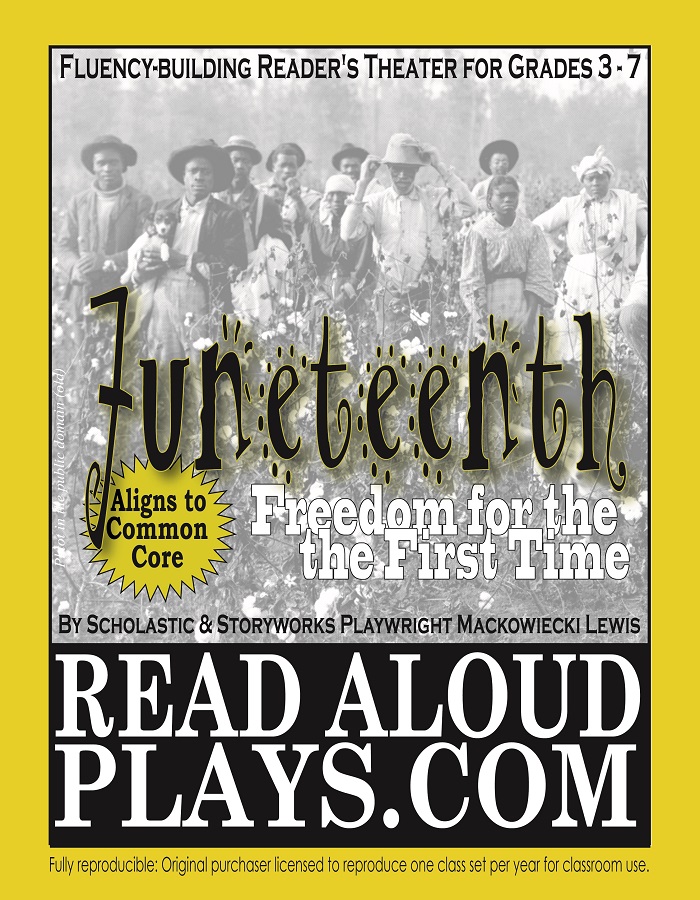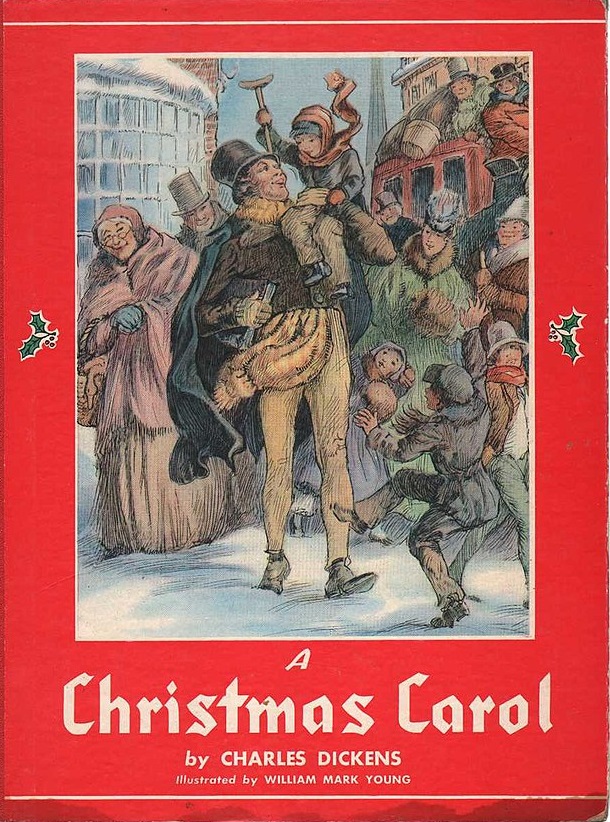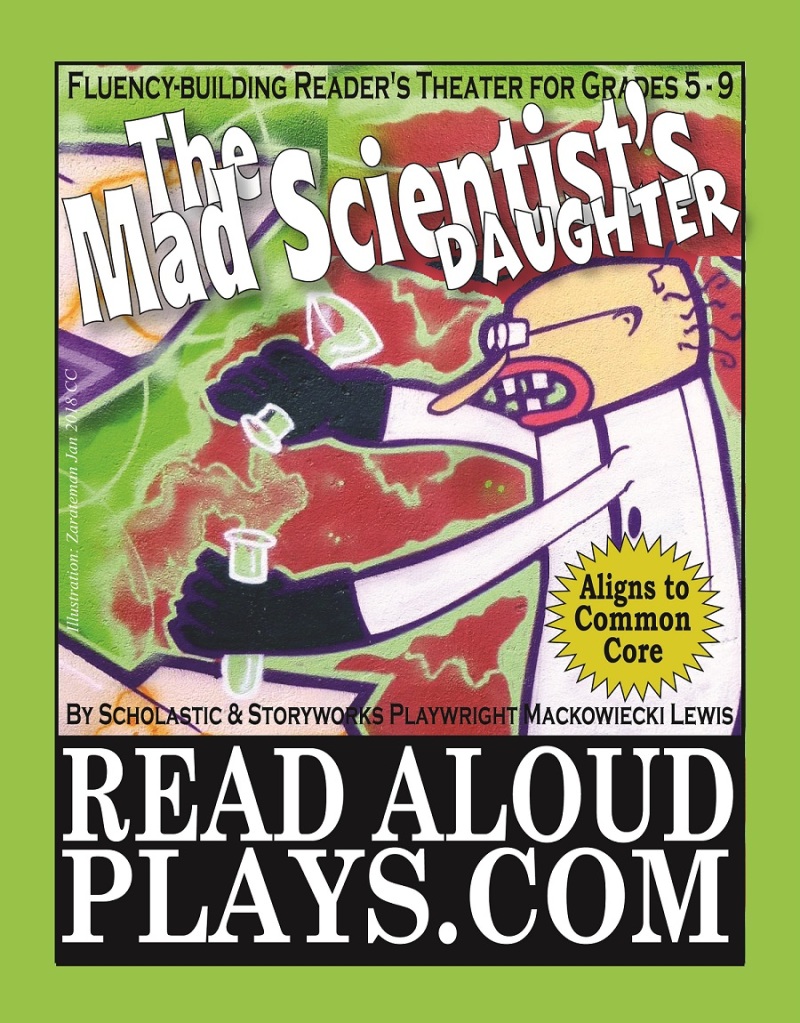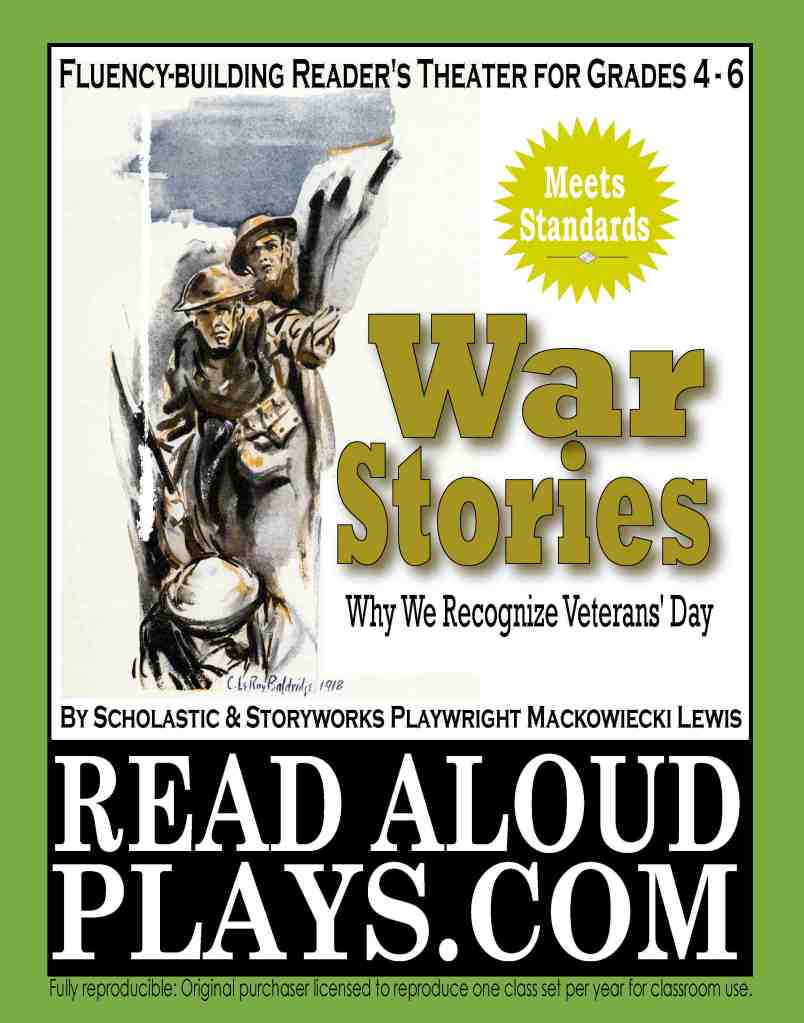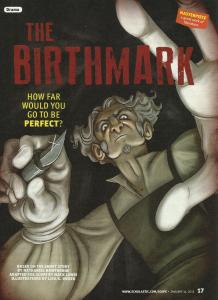If you’d like your students to have some insight into the real meaning of Veterans’ Day, considering downloading “War Stories.” The play originally appeared in my now out-of-print book, Read Aloud Plays: Symbols of America. It’s a somber reminder of the sacrifices made by our war heroes. The play comes with a set of comprehension activities and full reproduction rights, which means the original downloader can copy a full class set for use in his or her classroom every year. Whether read once through, used as a literature circle activity, or enacted on stage, it’s an engaging way to reveal to your students the real meaning of the holiday. Be sure to also check out my other American history plays on TeachersPayTeachers. Happy directing!
Category Archives: Uncategorized
Your Juneteenth Playlist
My most poignant play—and it’s perfect for celebrating Juneteenth! Based on actual slave narratives, Freedom for the First Time is historically-accurate, kid-friendly, and comes embedded with comprehension questions and historic photos. It’s the narrative of ten-year old Tyree, a slave during the time of the Civil War. Like many slaves, Tyree believes whatever her masters say. But when Tyree’s brother, Sweet Walter, arrives with a band of Union soldiers to tell her the war is over, she and her family experience their day of Jubilee, the day they know freedom for the first time. Pair it with Days of Jubilee, Patricia and Frederick McKissack’s exceptional non-fiction book about slavery and the Civil War. Click here to see the fantastic things the kids at the Baker Montessori School in Houston did with the script! It’s available on TpT and Etsy, and like all my plays, it includes performance rights. Be sure to also check out Box Brown’s Freedom Crate and Richard Wright & the Library Card. Happy directing!
Have a Dickens of a Christmas!
We all know that last week before Christmas vacation can be a real bugger in the classroom. The kids get so worked up about yule logs and gingerbread houses (or, more truly, about the L.O.L. Doll Box or Nintendo Switch under the tree), they’re no longer able to see straight, let alone sit still for a geometry test. You can have one Dickens of a Christmas, though, by adding a couple holiday plays to your Santa letters and holiday art projects.
Charles Dickens, of course, is the undisputed master of Christmas-oriented literature, so allow me to share with you some nifty class plays based on his life and work.
Whether you plan to fully enact it or just play around with it during language arts class, my traditional, kid-friendly version of a Christmas Carol is a great place to start. Challenging for 3rd, but great for 4th-6th graders. If you want to take things a bit further, consider creating a movie version, or merely having your students adapt the play to their liking. A few years ago my fifth graders added extra dialogue, a few additional scenes, and a contemporary setting to my script to make this lovely sixteen minute film. Use it as an introduction to your work on the play (it’ll really motivate your students) or as a follow-up compare and contrast activity.
Consider pairing Scrooge with ol’ Gabriel Grub. This script is a spooky, Christmas tale about a grumpy grave digger who is dragged away on Christmas Eve by a group of wretched goblins. It’ll scare the dickens out of the younger kids, but your fourth through eighth graders will find it a fun and fascinating comparison to Scrooge. You can check out a radio pod cast my students created by clicking here.
Another Dickens classic comes from his novel, Great Expectations. My original play depicts the opening chapters. Though not explicitly about Christmas, it takes place on Christmas Eve when the orphaned Pip encounters an escaped convict on the marshes. It’s full of angst and adventure, but best suited for 6th through 9th graders (though a talented or motivated group of 5th graders could probably handle it, too.
Along with any of these, you simply must try my wonderful play about Charles Dickens’ childhood, Escape from the Blacking House. I think a great triple play Christmas show would use Blacking House as an introduction to Grub and Scrooge. But even if you merely want your kids to have more engaging access to some holiday stories, these plays are great just for in-class reading. (Build fluency be reading them twice.) All these plays, along with The Gift of a Magi and others, are available on my TpT storefront.
So if you want to have a great week before the vacation, put away that geometry test. Show your Christmas spirit with some holiday plays.
Happy directing!
War Stories
Both my parents served in the military. My mom had a short stint as a WAC in DC before landing in the secretarial pool at the White House. She eventually had a temporary assignment working for Matthew Connelly, Harry Truman’s executive secretary. She used to tell a story about sneaking down a long corridor in hopes of seeing the presidential swimming pool before being caught by a guard and sent back to her post. Despite her brush with security, she was eventually offered a permanent position but, regretfully I suspect, turned it down because the bus commute from her quarters in Virginia was too long. Those, she would later tell me, were the best years of her life.
My dad, meanwhile, served in both World War II and Korea. I’m told his experiences were vast and extreme, that he piloted a plane, that he commanded a POW camp, that he was at the disastrously fierce Battle of Kasserine Pass. But he himself never spoke of any of it. Not a word. For him it was far too painful—as it is for many veterans.
It was with them in mind that I crafted “War Stories” for Scholastic several years ago. It speaks to the pain of war, the sacrifice of those who’ve served, and the meaning of Veterans’ Day. I encourage you to share it with your students in grades four and up prior to the holiday on November 11.
Happy directing.
A New Play for Halloween
Back a hundred years ago, ghoulishness was captured in short stories rather than comic books. Writers like Poe, Shelley, and Stevenson creeped out their audiences with dark tales of superstition, mystery, and insanity. The Gothic themes they created have been permeating literature, television, and cinema ever since. Case in point, for the last couple of years I’ve been not-quite-binge watching episodes of Dark Shadows, the Gothic TV show about Barnabas Collins—arguably the world’s second-most famous vampire (Step aside, Edward). The show’s witches, werewolves, and headless dudes had me mesmerized when it originally aired back in the 1960’s. Now, viewing the rather campy soap through adult eyes, I’m recognizing that all its creepiness came from classic short stories like The Cask of Amontillado, Frankenstein, and The Headless Horseman. They’re all in there! Go figure.
Your students know these themes, too. They’ve seen them on the Simpsons and Family Guy, in Goosebumps and Marvel Comics. But do they know from whence they come? Though the archaic language and complex structures of these classic tales present barriers for most middle grade readers, you can make the stories more accessible by pairing them with reader’s theater. And what better a time to do it than Halloween?
So what if your students are mesmerized by Venom and Doctor Octopus? There are plenty of mangled monsters and the criminally insane in W.W. Jacob’s classic, The Monkey’s Paw, Poe’s The Tell-Tale Heart, and Hawthorne’s The Birthmark. They’ll also find that familiar ol’ headless horseman in Sleepy Hollow, and a hapless ghost in Twain’s A Ghost Story. Finally, I’ve just released my version of Rappaccini’s Daughter. No, your kids won’t find it Pennywise-creepy or Slenderman-scary, but its chemical concoctions and mad scientists make it very nearly as engaging. Most certainly, it’s a key to unlocking the original’s subtleties and complexities.
All these plays are available on my TeachersPayTeachers, Etsy, and Amazon storefronts. They’re critically-acclaimed. They’re cheap. And they each come with a comprehension exercise. Suitable for reader’s theater, podcast radio drama, or full stage production, they’re perfect for fifth graders and up— but get started early to have them well-rehearsed by Halloween.
Happy directing!
Gabriel Grub Holiday Radio Drama
How to Honor Veterans
As a way to honor America’s veterans, I’m offering my play “War Stories” for free through Veteran’s Day. All you have to do is visit my TeachersPayTeachers site. The play originally appeared in my now out-of-print book, Read Aloud Plays: Symbols of America. It’s a somber reminder of the sacrifices made by our war heroes. The play comes with a set of comprehension activities and full reproduction rights, which means the original downloader can copy a full class set for use in his or her classroom every year. It’s an engaging way to reveal to your students the real meaning of the holiday. Be sure to also check out my other American history plays. Happy directing!
Remotely Spooky!
Ugh! If you’re at all like me, trying to READ with a group of students online is a nightmare worthy of Halloween. Connectivity issues, background noise, home distractions…these are problems regardless of the content. But the glitch that bugs me the most is … well, it’s ME! I’m constantly having to interrupt the “flow” in order to identify and cue the next reader. I use my annotation marker to scribble all over the screen. “Nate is up next, Cynthia is after that…” What exactly are we reading about? the kids must be thinking.

Let me offer the antidote: reader’s theater. Drama is traditionally a collaborative, in-person activity, so when we turned to remote instruction last spring, I assumed reader’s theater would be off the instructional table. What I’ve discovered since is that RT remains an excellent resource. This is why: when parts are assigned beforehand, students know when to come in. They know when to read, which means I can sit back and actually hear them.
On top of that, kids are often willing to read a script repetitively, which gets at fluency like nothing else. And when you tell them you’re going to practice for a week or two and then record your online session as a “Zoomer’s Theater” performance, they’re especially engaged.
Because it’s a performance, reader’s theater is also its own assessment. None-the-less, my plays come with comprehension activities that have been prepared for remote instruction using TpT’s digitizing tool (which turns them into fillable PDFs).
Of course, Halloween is going to look a lot different this year too, which makes some spooky “Zoomer’s Theater” a welcome addition to your remote instruction. Here are a few plays that your kids will love:
(Here I must interrupt our flow with a note about copyright…please be careful how you make Read Aloud Plays available to your students. Allowing your students to download a copy for use at home is encouraged, but make sure that download link is private. It should be within a passcode protected environment such as SeeSaw or Google Classroom. If the general public can see or print it, it’s a copyright violation.)
Happy directing!
John Lewis
 In memoriam: John Lewis. If we’re to judge a person based on the content of their character, as Dr. King implored, then John Lewis surely was on the mountain top. His work could always be characterized as dignified, purposeful, and courageous. He was a true crusader for human rights.
In memoriam: John Lewis. If we’re to judge a person based on the content of their character, as Dr. King implored, then John Lewis surely was on the mountain top. His work could always be characterized as dignified, purposeful, and courageous. He was a true crusader for human rights.
Presidents’ Day Has Been Rescheduled
These days Presidents’ Day is viewed by most students as merely an extra day off from school. Here’s how to give meaning to the day.
It’s quite possible we will never again see a president as popular as George Washington. He is known as “the father of our country” because of all he did to bring about independence from England. He led the United States to victory in the Revolutionary War, and afterwards became the country’s first president despite never wanting the job. Contrast that to how desperately people seem to want the job today! Washington served out of a sense of duty, and he never accepted pay. No wonder it was said of him, “First in war, first in peace, and first in the hearts of his countrymen.” In fact, Washington was so popular people started meeting in taverns, giving speeches, or going to extravagant balls to celebrate his birthday while he was still in office! His sudden death three years later only made people want to honor him that much more. As a result, “Washington’s Birthday,” which is on February 22nd, has been celebrated ever since.
Don’t see it on the calendar? That’s because in 1865 another beloved president died suddenly. Though Abraham Lincoln’s presidency had been controversial, he is considered one of America’s greatest leaders. Though his birthday on February 12th did not become a federal holiday like Washington’s, it was celebrated in many states. Then, in 1968, Congress made changes to several holidays to simplify the calendar. Washington’s Birthday became the third Monday in February, regardless of whether or not it fell on the 22nd. Because Lincoln’s Birthday is also in February, many people started calling the third Monday “Presidents’ Day” in honor of both Washington and Lincoln. Today, though still officially called Washington’s Birthday by Congress, the third Monday in February is thought of as a day to recognize all those who have served the nation as president—even the ones many of us have never heard of such as Martin President Van Buren (upper left).
 All those dates aside, you can bring lasting meaning to the day simply by using my “Presidents’ Day Dream” play this week. The play looks at the Presidency from a different viewpoint. In modern times it seems everybody wants to be Commander-in-Chief. When the play’s lead begins day dreaming about how great it would be, she’s met in her “dream” by various former presidents. Each speaks openly and honestly about the challenges and hardships of the job while pointing out the qualities it takes to be a good leader. In so doing they give her and the audience a unique character-building history lesson on being the President. The embedded political cartoons add to the lesson, showing students that elections have always been contentious and presidents often criticized.
All those dates aside, you can bring lasting meaning to the day simply by using my “Presidents’ Day Dream” play this week. The play looks at the Presidency from a different viewpoint. In modern times it seems everybody wants to be Commander-in-Chief. When the play’s lead begins day dreaming about how great it would be, she’s met in her “dream” by various former presidents. Each speaks openly and honestly about the challenges and hardships of the job while pointing out the qualities it takes to be a good leader. In so doing they give her and the audience a unique character-building history lesson on being the President. The embedded political cartoons add to the lesson, showing students that elections have always been contentious and presidents often criticized.
Consider pairing it with my laugh out-loud play, “Argument at Mount Rushmore.” It gives students a look at the unique personalities of Lincoln, Jefferson, Washington, and Roosevelt. It imagines their sixty-foot tall faces on Mount Rushmore are “discussing” the merits and accomplishments of each of their presidencies. Though built on a humorous platform, it’s a historically-accurate portrayal of the gracious Washington, the witty Lincoln, and the always-enthusiastic Roosevelt. As for the sometimes over-looked and often under-appreciated Jefferson, well, let’s just say he gets a bit bent out of shape. This play is always a hit, especially if you’re industrious enough to build your own Mount Rushmore set!
Both plays originally appeared in Read Aloud Plays: Symbols of America (Scholastic, 2003). Though obvious works of fiction, the details were carefully researched and subsequently reviewed by professional editors at Scholastic. On top of all that, they’re inexpensive. Both plays come with a comprehension activity, a paired text “pre-reading” activity, teacher notes and keys, and a classroom license. Just click on the cover to download the free preview at TeachersPayTeachers!
Happy directing!


